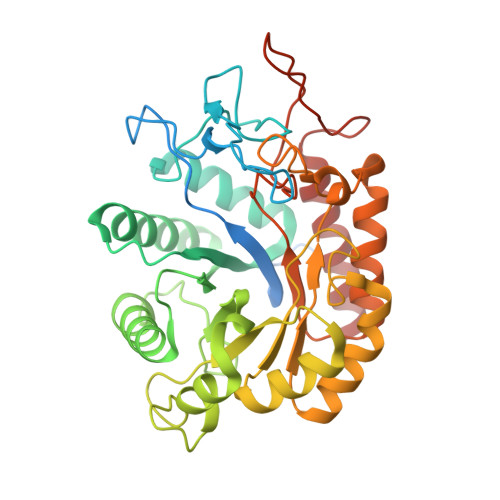Exploration of Strategies for Mechanism-Based Inhibitor Design for Family GH99 endo-alpha-1,2-Mannanases.
Fernandes, P.Z., Petricevic, M., Sobala, L., Davies, G.J., Williams, S.J.(2018) Chemistry 24: 7464-7473
- PubMed: 29508463
- DOI: https://doi.org/10.1002/chem.201800435
- Primary Citation of Related Structures:
6FAM, 6FAR - PubMed Abstract:
endo-α-1,2-Mannosidases and -mannanases, members of glycoside hydrolase family 99 (GH99), cleave α-Glc/Man-1,3-α-Man-OR structures within mammalian N-linked glycans and fungal α-mannan, respectively. They are proposed to act through a two-step mechanism involving a 1,2-anhydrosugar "epoxide" intermediate incorporating two conserved catalytic carboxylates. In the first step, one carboxylate acts as a general base to deprotonate the 2-hydroxy group adjacent to the fissile glycosidic bond, and the other provides general acid assistance to the departure of the aglycon. We report herein the synthesis of two inhibitors designed to interact with either the general base (α-mannosyl-1,3-(2-aminodeoxymannojirimycin), Man2NH 2 DMJ) or the general acid (α-mannosyl-1,3-mannoimidazole, ManManIm). Modest affinities were observed for an endo-α-1,2-mannanase from Bacteroides thetaiotaomicron. Structural studies revealed that Man2NH 2 DMJ binds like other iminosugar inhibitors, which suggests that the poor inhibition shown by this compound is not a result of a failure to achieve the expected interaction with the general base, but rather the reduction in basicity of the endocyclic nitrogen caused by introduction of a vicinal, protonated amine at C2. ManManIm binds with the imidazole headgroup distorted downwards, a result of an unfavourable interaction with a conserved active site tyrosine. This study has identified important limitations associated with mechanism-inspired inhibitor design for GH99 enzymes.
- School of Chemistry, Bio21 Molecular Science and Biotechnology Institute, University of Melbourne, Parkville, Vic, 3010, Australia.
Organizational Affiliation:


















